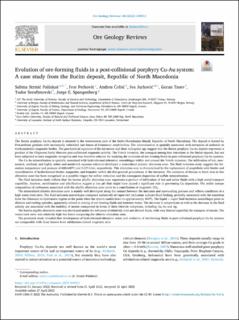| dc.contributor.author | Strmic Palinkas, Sabina | |
| dc.contributor.author | Perkovic, Ivor | |
| dc.contributor.author | Čobić, Andrea | |
| dc.contributor.author | Jurkovic, Iva | |
| dc.contributor.author | Tasev, Goran | |
| dc.contributor.author | Serafimovski, Todor | |
| dc.contributor.author | Spangenberg, Jorge E. | |
| dc.date.accessioned | 2022-06-22T09:09:05Z | |
| dc.date.available | 2022-06-22T09:09:05Z | |
| dc.date.created | 2022-06-04T08:21:58Z | |
| dc.date.issued | 2022 | |
| dc.identifier.issn | 0169-1368 | |
| dc.identifier.uri | https://hdl.handle.net/11250/2999982 | |
| dc.description.abstract | The Bučim porphyry Cu-Au deposit is situated in the westernmost part of the Serbo-Macedonian Massif, Republic of North Macedonia. The deposit is hosted by Precambrian gneisses with tectonically imbedded rare lenses of Palaeozoic amphibolites. The mineralization is spatially associated with intrusions of andesitic to trachyandesitic magmatic bodies. The geochemical signature of the intrusions and their radiogenic age suggest that the Bučim porphyry Cu-Au deposit represents a product of the Oligocene/Early Miocene post-collisional magmatic activity. The Vršnik intrusion, the youngest among four intrusions at the Bučim deposit, has not been subjected to later magmatic overprints and was therefore selected for studying the evolution of ore-forming fluids in post-collisional porphyry Cu-Au systems.
The Cu-Au mineralization is spatially associated with hydrothermal alteration assemblages within and around the Vršnik intrusion. The infiltration of hot, near-neutral, oxidized, and highly saline and metal-rich aqueous solutions developed a mineralized potassic alteration zone. The fluid inclusion study suggests the formation temperature and pressure of 600-645⁰C and 0.675 kbar, respectively. This alteration zone is characterized by the replacement of amphibole with biotite and crystallization of hydrothermal biotite, magnetite, and hematite within the fine-grained groundmass of the intrusion. The oxidation of ferrous to ferric iron in this alteration zone has been recognized as a possible trigger for sulfate reduction and the consequent deposition of sulfide mineralization.
The fluid inclusion study reflects that the barren phyllic alteration zone represents a product of infiltration of hot and saline fluids with a high metal-transport capability. Anyhow, sericitization and silicification suggest a low pH that might have played a significant role in preventing Cu deposition. The stable isotope composition of carbonates associated with the phyllic alteration zone point to a contribution of magmatic CO2.
The mineralized chlorite alteration zone is mainly well developed along the contact between the intrusion and surrounding gneisses and reflects conditions of a high water/rock ratio. The fluid inclusion assemblages composed exclusively of vapor-rich inclusions indicate fluid flashing, probably associated with the transition from the lithostatic to hydrostatic regime at the point when the system cooled down to approximately 400⁰C. The liquid + vapor fluid inclusion assemblages point to dilution and cooling episodes, apparently related to mixing of ore-bearing fluids and meteoric water. The decrease in temperature as well as the decrease in the fluid salinity are associated with the mobility of metals transported in forms of their chloride complexes, including Cu, Au and Ag.
The barren argillic alteration zone was developed under the influence of relatively cold and diluted fluids, with very limited capability for transport of metals. The water/rock ratio was relatively high but lower comparing the chlorite alteration zone.
The presented study revealed that development of hydrothermal alteration zones and evolution of ore-forming fluids in post-collisional porphyry Cu-Au systems are comparable with those known from subduction-related magmatic arcs. | en_US |
| dc.language.iso | eng | en_US |
| dc.publisher | Elsevier | en_US |
| dc.rights | Navngivelse 4.0 Internasjonal | * |
| dc.rights.uri | http://creativecommons.org/licenses/by/4.0/deed.no | * |
| dc.title | Evolution of ore-forming fluids in a post-collisional porphyry Cu-Au system: A case study from the Bučim deposit, Republic of North Macedonia | en_US |
| dc.type | Journal article | en_US |
| dc.type | Peer reviewed | en_US |
| dc.description.version | publishedVersion | en_US |
| dc.rights.holder | Copyright 2022 The Author(s) | en_US |
| dc.source.articlenumber | 104913 | en_US |
| cristin.ispublished | true | |
| cristin.fulltext | original | |
| cristin.qualitycode | 1 | |
| dc.identifier.doi | 10.1016/j.oregeorev.2022.104913 | |
| dc.identifier.cristin | 2029478 | |
| dc.source.journal | Ore Geology Reviews | en_US |
| dc.identifier.citation | Ore Geology Reviews. 2022, 146, 104913. | en_US |
| dc.source.volume | 146 | en_US |

